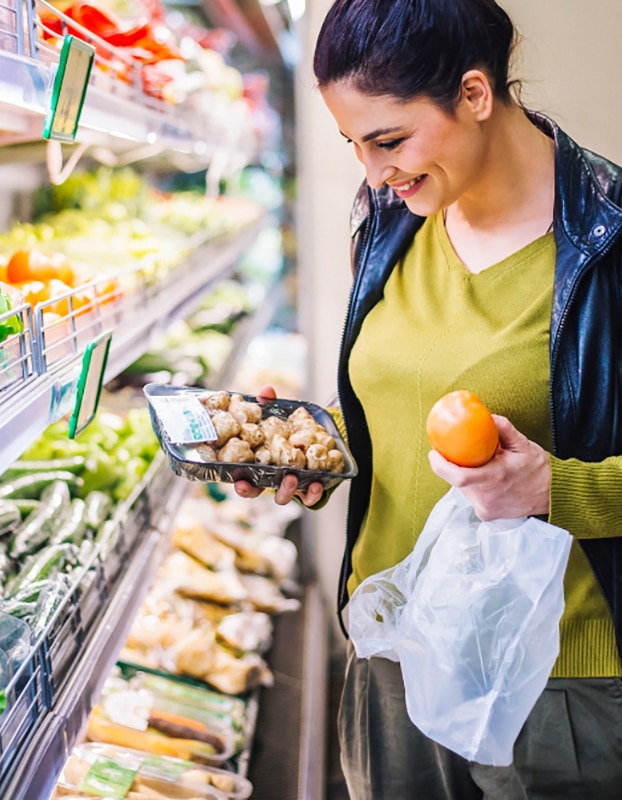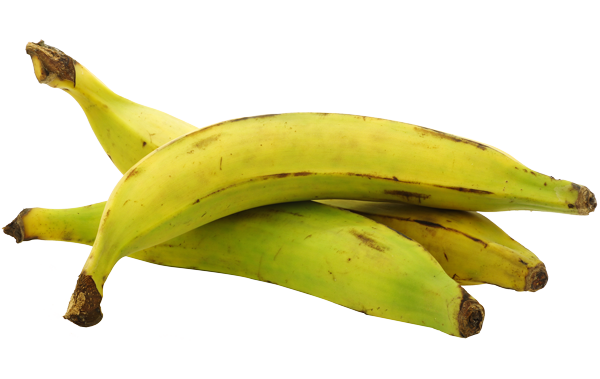Health
benefits
A good source of energy
Plantains contain complex carbohydrates that provide long-lasting energy. However, they must be eaten cooked to provide their benefits.
Plantains are also:
- a source of potassium (for the nervous system, muscular function, and blood pressure)
Nutritional composition
When is the right
time to eat them?
All year.
Plantains are available year-round.
Choosing and
storing plantains
Choose your plantains well :
- Plantains should be firm to the touch and should not have spots.
- Choose the ones that are just barely ripe.
Properly store your plantains :
- Plantains can be stored for seven to ten days at room temperature.
- They should be refrigerated if they are very ripe.
- Once peeled and individually wrapped, they can also be frozen.
Anti-waste tips
What about making croquettes? Cut the plantain into thin slices and shape these into little balls. Roll these balls through flour, then beaten egg, and then breadcrumbs, and put them straight into the fryer!
And the skin? Use it as fertilizer, or put into your green waste to compost.
.
What is the environmental impact?
The Product Environmental Footprint (PEF), a score established by Agribalyse*, tells us more! It takes account of all the phases in a vegetable’s life cycle: how it’s grown, the impact of its transport, the impact of its processing, and so on. The lower the score, the lower the environmental impact :
- Plantain, raw: 0.13
- Plantain, cooked: 0.26
- Steak, raw: 2.77
*Data taken from the Agribalyse database, which gives the environmental score of foodstuffs. This unique score is the average of 16 indicators, calculated using the European methodology PEF. It is not the same as an environmental label or “eco-score”.
CO2 equivalent: for 100g of cooked plantain: 0.186 kg of CO2 eq, which is the same as 5.5 g of steak or driving 744 m by car
Tips and
tricks
How to prepare plantain
Unlike yellow bananas, plantains are never eaten raw. Like bananas, however, they need only be peeled before boiling or frying them. Their skin can also be set aside and cooked in the oven (as you would cook eggplants).
Eaten as a vegetable, plantains are most often eaten cooked, whether savory or sweet. When they are cooked before they have reached full maturity, they are firmer, less sweet, and similar in texture to tubers.
Plantains go well with…
Plantains can be eaten as a side dish with red meat, chicken, and fish. They go well with curries, stews, spicy sauces, and melted cheese. They also are delicious in rice-based dishes and with coconut milk, in sweet and savory preparations.
In several traditional dishes, plantains are served fried (for example, in the African alloco).
Since plantains resemble sweet potatoes in taste more than bananas, they can be prepared and served like a potato: roasted in the oven, sautéed, pureed, or made into fritters, for example.
Can everyone
eat them?

Young children
Children can start eating plantains at 8 months, in puree form, sautéed, or roasted.
And everyone else…
The taste of plantains, less sweet than that of bananas, can be a surprise to those who aren’t familiar with it, but their melt-in-your-mouth texture makes them a vegetable that everyone can easily enjoy.
See plenty of other tips for encouraging children to eat vegetables
Where do they come from?
Origins and varieties
Origins
The main plantain-producing countries are located in Latin America, Asia, and Africa.
Plantains are a staple in Africa, the West Indies, and South America. Canadians also consume many plantains.
Bananas and plantains: what’s the difference?
Bananas and plantains can be considered to be cousins. Plantains are generally larger and longer than the traditional yellow banana. Their skin is green and thicker, while their inside is firm, less sweet, and higher in starch, making it hold up well when cooked. Plantains are especially eaten as vegetables, unlike bananas. Their French name means “plantain bananas,” while in the United States and African countries, they are called “plantains,” with no mention of bananas. This helps avoid any possible confusion.



 Celery
Celery  Bell pepper
Bell pepper  Plant a Fast-Growing, Natural Vegetable Patch
Plant a Fast-Growing, Natural Vegetable Patch 









